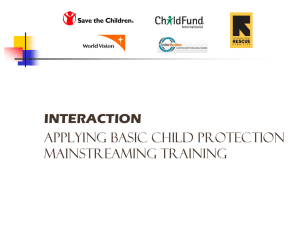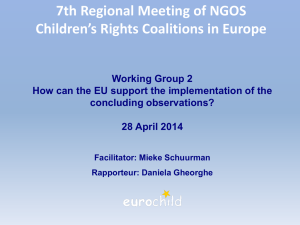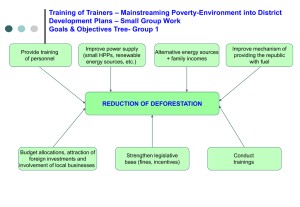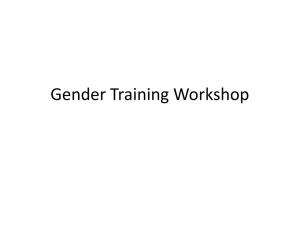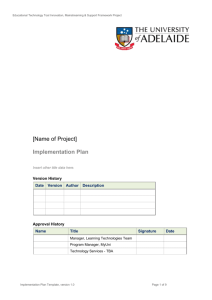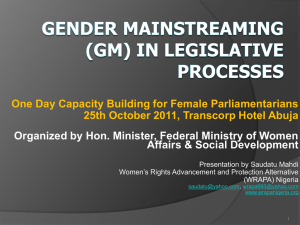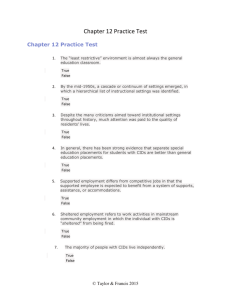Integration of Gender in Pro-poor Policies and Initiatives: A
advertisement
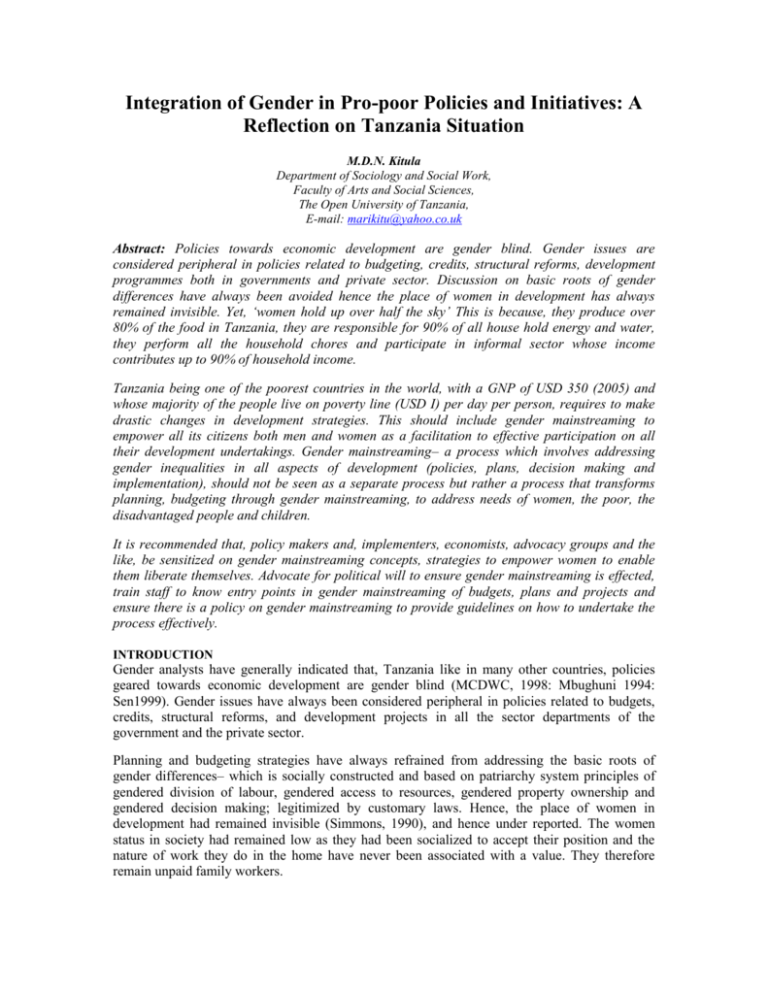
Integration of Gender in Pro-poor Policies and Initiatives: A Reflection on Tanzania Situation M.D.N. Kitula Department of Sociology and Social Work, Faculty of Arts and Social Sciences, The Open University of Tanzania, E-mail: marikitu@yahoo.co.uk Abstract: Policies towards economic development are gender blind. Gender issues are considered peripheral in policies related to budgeting, credits, structural reforms, development programmes both in governments and private sector. Discussion on basic roots of gender differences have always been avoided hence the place of women in development has always remained invisible. Yet, ‘women hold up over half the sky’ This is because, they produce over 80% of the food in Tanzania, they are responsible for 90% of all house hold energy and water, they perform all the household chores and participate in informal sector whose income contributes up to 90% of household income. Tanzania being one of the poorest countries in the world, with a GNP of USD 350 (2005) and whose majority of the people live on poverty line (USD I) per day per person, requires to make drastic changes in development strategies. This should include gender mainstreaming to empower all its citizens both men and women as a facilitation to effective participation on all their development undertakings. Gender mainstreaming– a process which involves addressing gender inequalities in all aspects of development (policies, plans, decision making and implementation), should not be seen as a separate process but rather a process that transforms planning, budgeting through gender mainstreaming, to address needs of women, the poor, the disadvantaged people and children. It is recommended that, policy makers and, implementers, economists, advocacy groups and the like, be sensitized on gender mainstreaming concepts, strategies to empower women to enable them liberate themselves. Advocate for political will to ensure gender mainstreaming is effected, train staff to know entry points in gender mainstreaming of budgets, plans and projects and ensure there is a policy on gender mainstreaming to provide guidelines on how to undertake the process effectively. INTRODUCTION Gender analysts have generally indicated that, Tanzania like in many other countries, policies geared towards economic development are gender blind (MCDWC, 1998: Mbughuni 1994: Sen1999). Gender issues have always been considered peripheral in policies related to budgets, credits, structural reforms, and development projects in all the sector departments of the government and the private sector. Planning and budgeting strategies have always refrained from addressing the basic roots of gender differences– which is socially constructed and based on patriarchy system principles of gendered division of labour, gendered access to resources, gendered property ownership and gendered decision making; legitimized by customary laws. Hence, the place of women in development had remained invisible (Simmons, 1990), and hence under reported. The women status in society had remained low as they had been socialized to accept their position and the nature of work they do in the home have never been associated with a value. They therefore remain unpaid family workers. Yet, “women hold up over half the sky” as per Chinese adage (Dixon, 1978) – despite their being neglected, especially those in rural areas. The reason is that, women, for example in Tanzania, are responsible for the production of almost 80% of the food crops, (Census, 2002), are responsible for household fuel wood accounting for 90% of all the household energy consumption, fetch water, perform all house hold chores and reproduce. Both rural and urban women are involved in the informal sector, which contributes up to 30% of the GNP. Womens contribution to the economy is through the informal sector, agriculture and the invisible, unvalued, unpaid domestic chores, and reproduction; are of great contribution to the economy of a poor country like Tanzania. The country, being one of the poorest in the world, ranks second poorest in Africa after Mozambique with a GNP per capital of equivalent to USD 350 (Bureau of Statistics, 2005). Agriculture is the back bone of the country’s economy– contributing to over 55% to the economy wherein 75% of the active population engaged in agriculture are women. About 90% of the 73.5% people living in rural areas live in poverty. Among these, the majority are women and children. Despite the roles played by women, the policies are gender blind hence are their programmes and implementation for economic development. Without explicit policy for gender mainstreaming to provide guidelines on how government departments should institutionalize gender internally and/or respond to the needs of both men and women in society, to ensure there is equal participation in development, the intended development for both national and millennium goals might not be reached at the expected time. The purpose of this paper is to analyze gender inequality prevailing in Tanzania, in relation to the poverty situation in the country. Specifically, the paper analyzes the roles played by women in the economy, the women status, rights and powers; and the government initiatives to address gender issues in development. The paper further provides alternative policy approaches to change and to effectively address issues of poverty from gender perspective. DEFINITION OF TERMINOLOGIES USED IN THE PAPER Gender: Gender refers to the socially constructed differences between men and women. It is an achieved status through psychological, cultural and social means to create maleness (masculinity) and females (femininity) kind of behaviour, social roles, sexual preferences, feelings and practices. A taboo of sameness is imposed by the society to enhance institutionalization of these socially constructed differences. The constructed social differences between men and women are achieved through socialization process following patriarchy system principles legitimized by both customary and civic laws. Gender Mainstreaming: Mainstream is the main widely accepted way of thinking or acting in relation to the subject. Gender mainstreaming refers to the consistent use of gender perspective at all stage of formulation, planning and implementation of policies, programme plans and projects (Rhynie 1999). The process involves integrating concepts by injecting such concepts into the existing whole to become part and parcel of that whole. BACKGROUND TO THE THEME AND POVERTY STATUS Background to the Theme Development planning structures and systems in Tanzania, like in many other countries, are used as means of ensuring that macro-economic goals are attained. The infrastructural development and services within the development plan are driven by economic goals, rather than the need to advance human development. In the process of attaining economic goals, the social development of people and particularly, women has often been neglected. This, therefore, has led to the tendency of planning to have a sector bias resulting in fragmented compartmentalized approach which ignores cross-cutting gender needs and concerns. Hence, the failure to meet needs of women in different sectors. In some countries, and in Tanzania specifically, where gender consideration has been made, especially in health and education and in other public spheres, related changes have not been effected to affect the private spheres, the home gender relations, a factor which has proved difficult. This, therefore, has contributed to women’s failure to make effective use of changes made in the public sphere to realize gender equality. The perpetuation of gender blind policies and plans is not only costly to the government as a whole, but also to individual families especially the children and women. Neglecting gender issues in policy and planning sustain inefficiency in the development process, because, it increases costs and lowers output due to lack of participatory planning and decision making of both men and women. Also, it lowers people’s capacity to participate in development and improve their well-being. This has therefore, perpetuated poverty in nations. Studies in agricultural productivity in Kenya, for example, has shown that, full participation of women in such areas as planning, provision of credits to women, empowering them with education and enabling them to own resources like the land increased agricultural yield by 22% (Sen, Gopal and Maryam (ed), 1997). Studies in economic growth has shown that, where the female to male enrolment ratio is 1:1, has managed to raise GNP by 25% compared to those with more education enrolment disparities. A similar example is with regard to wage inequality elimination in Latin America between men and women with same education, skills and work experience. Such elimination of wage differences has culminated into a rise of national output of up to 5% (Elson, 1998). In Tanzania, studies have shown that, benefits to reduce gender based constraints, for example, in community of small holders, such as among coffee and banana growers, has increased household income by 10%, labour productivity by 15% and capital productivity by 44% (Elson, 1998). In another study, women in lake Victoria Basin, Tanzania areas, who had accessed loans, indicated an increased production of between 10%-20%, while those with land ownership titles showed an increased production of up to 68% than those without. And for those who make decisions, have direct access and control over resources, showed an increased production of up to 70% (Kitula, 2007). In workplace situations, there is generally an unmet needs of workers. There is alienation of workers from participation in the process of planning for programme implementation. Decisions are made from top, thus subjecting workers to powerless, valueless labour force, pressurized to work in places which they feel is not part of them. Commitment of workers is thus minimized where workers have no voice. This situation is even more serious to the women at work places. The reason is that, patriarchy system do function everywhere both in private and public spheres and the work place is not spared from patriarchy system. The majority of women are ghettorized into specific job categories (Statham, 1996). They are in stereotyped jobs like nursing, secretaries, school teachers, packing sections in factories, serving tea, cleaning offices and the like. Partly, this is the result of gendered education which results in low education and skills (Mbughuni, 1994). Empowering women with development tools like education, which has multiplier effect due to the roles and the socially assigned responsibilities, has profound impact on the economy. Further women access to resources and control over them and, their full participation in various development programmes on equal terms with men, promotes fast growth of the economy. However, this cannot be easily achieved in the rigid patriarchy system, which is reflected in Gender-blind policies, plans and programmes. Tanzania has so far developed a social sector strategy aiming at eradicating poverty and is striving to promote full community participation to foster economic growth. The social strategies include the decentralization of authority to local level, more resources close to households and concentrate public sector resources on core activities of the government. The goals for the social sector strategy might not be easily realized, if the issue of gender mainstreaming is not taken seriously in the policy, plans and programmes. Gender mainstreaming has to be part and parcel of the policy and planning process to ensure full integration of gender needs, interests and priorities. Mainstreaming gender and integration of gender into policies, planning, and implementation is possible only when the mind set of those involved in policy formulation, planning, economic analysis and implementers is fully aware of the concepts and sensitized enough to understand the importance of doing so. This is possible only when there is a political will. Poverty Status Poverty refers to the state of being poor. The concept of being poor, depends on individual perspective, the class and status of an individual. One might say being poor while referring, to not being able to buy a car or owning a luxurious house. While on the other hand, poor may refers to one having not enough to buy basic needs like food, clothing and a bed to sleep on. Poverty from gender perspective refers to lack of power over resources which include level of access of and control over those resources such as land, credits/loans, agricultural outputs, knowledge and related factors which are necessary for economic development. Tanzania poverty level is very high. The country is facing serious economic problems. The poverty profile indicates that about 51% of the population of Tanzania has income less than an absolute poverty line of USD 1 per day per person. About 42% of Tanzania population, live under extreme poverty of below USD 0.75 per day per person by year 1991. This has shown slight improvement from the 1983 situation of 65% of the population living under poverty line of USD 1 while 51% of them were living under extreme poverty of below USD 0.75 (Social Sector Review, 1991). With a GDP per capita of USD 200 in 1996, Tanzania ranked second poorest country in Africa after Mozambique. The poor communities of Tanzania are characterized by low education levels, high infant and child mortality and morbidity, low life expectancy of below 50 years, high fertility and gender inequality. Such a situation which forms a vicious circle, creates difficulties to disentangle and hence problematic in finding solutions to poverty problems. The bottom line of this situation is that, the majority of these poor are women. Yet, these are the people who play a big role in production especially in village in rural areas. These women who form the back bone of the rural economy, live in perpetual poverty because, they don’t own the land which they use everyday for subsistence crop production. Customary law does not allow women to own land. Inheritance of land was on male passage, a patriarchal system demonstrated through patrilineal practices. (Kitula, 2007). This barrier of women to access land, was further a “glass ceiling” to access credits. Women are thus discriminated through the customary laws. Furthermore women are used to produce cash crops, yet, do not benefit the proceeds of their labour because after harvest, men take full charge of the produce. Lack of women access to and control over these resources is exacerbated by their subordinated position within the patriarchal communities in which they live. The subordinated position of women has further led to the seemingly invisible roles and contribution women make to the economy; to warrant planners, policy makers, economists and managers to put a value to these roles they play, consequently driving them into extreme poverty. Economic Activities Agriculture Agriculture in Tanzania is the backbone of the economy which contributed up to 62% of Tanzania income in 1992 and 55% of Tanzania income in 1995 (TGNP, 1999). However, production pattern is limited by the rigid sexual division of labour which assign women subsistence crop-production and in reproduction of labour; and discriminatory ownership of land which create a barrier to credit acquisition for investment. Yet, women form the back-bone of agricultural labour making up to 75% of the labour force in agriculture producing about 80% of the subsistence crops. Low prioritization of the sector by the government is another contributing factor to low production as there is little or no reinvestment. This has greater negative impact on the poor majority and those hit hard are the women who absorb all the shocks of poverty. Moreover, the technology used in the sector is still too low to realize any economically viable produce. The total dependence on rainfall and the shaky capital of the farmers to buy farm inputs, exacerbates the situation which results in low productivity thus perpetuating poverty. Informal Sector The informal sector is an important alternative form of income generation in Tanzania. Malyamkono and Bagachwa (1990) research finding as quoted by Mbughuni (1994), indicated that, the contribution of informal sector to the national GNP was up to 30%. It was also indicated that the informal sector in Dar es Salaam for example contributed up to 90% of the household income. It was further indicated that women participating in the informal sector formed 65% of all involved. Informal sector in rural areas has also taken an important position in the rural economy. It was indicated by Tripp (1989) as quoted by Mbughuni (1994) that, rural women involved in the informal sector, were active in the sell of stereotyped products. About 90% of these were engaged in the sell of stereotyped items such as locally brewed beer, cooked food, and agricultural products. However, due to lack of credits and poor technologies used, most of such projects don’t expand much. The poverty conditions have thus never parted them. Wage Employment in Tanzania The proportion of wage earners in Tanzania in 1980s was about 20%. Out of these, 15.6% were women. Among the high and middle level posts, only 20% were occupied by women. Out of the 538 managers of the institutions both private and public, only 69 were females and out of 130 legislative officials and government administrators, only 6 were women. It can generally be deduced that, women in wage labour are still very few. But more to this, it is indicated that, there is gendered patterns of employment within the formal sector. Women are concentrated in traditional service fields such as nursing which constitute 69% of the total employed, clerical work and teaching. The wages they are paid is related to the low level of education and nature of work they do. The glaring differences in terms of work positions between men and women, is a consequence of low enrolment of females in the education system. For example, higher education statistics show that, only about 30% females are enrolled in higher education institutions. The rest join training for stereotyped jobs like secretaries, nursing, teaching, clerical jobs, cleaning, packing products in factories and in all jobs that don’t need high skills due to the level of their education, a consequence of engendered education system, lack of enforcement of law for selection of women in employment, and overall system of gender discrimination. Women Position in Production In Agriculture Both men and women do work in the farm. However, Statistics indicates, as earlier shown, that women dominate in the sector. Women continue to be beasts of burden in agriculture using poor technology, such as the hand hoe. They till the land which they do not own; they weed, harvest, transport, process and preserve the food crops. The backwardness of the technology, the rigid sexual division of labour which over burdens women in both production and reproduction tasks, the land tenure system, the unequal distribution of resources and the unequal benefits of the proceeds of their labour; acts as a barrier towards improvement in the sector. Indicating how much women are over burdened with responsibilities compared to men in rural areas, Nyerere (1969) observed that: ….. women did and still do more work than their share of work in the field and in homes. This is inconsistent with the concept of equity of all human being and right of all to live in security and freedom. If we want our country to make full and quick progress now it is essential that, women live in terms of full equality with their fellow citizen who are men. In his book titled “Freedom and Socialism”, Nyerere argues that: It would be appropriate to ask our farmers especially men, how many hours a week and how many hours a year they work …. The truth is that, women in villages work very hard. At times, they work 12-13 hours a day. They even work on public holidays. Women in villages work harder than everybody else in Tanzania. But men who live in villages are on leave for half of their lives. Taylor, (1984) Discussing the same issue, Taylor, (1984) said that: Women everywhere work harder than men, but in Africa, they work hardest of all, bearing the children of the family, survives without sharing the benefits of their economic power.. the result. Itself is locked together with sexual inequality, Africa will stay poor until its Women are free. Tanzania Government Initiatives for Change As earlier indicated, Tanzania had embarked on various social sector development strategies for change. Such changes include decentralization of authority to local level, sector reforms especially in education and health by emphasizing on sector core activities and putting more resources closer to households to promote household investments in human capital. The HIPIC initiatives, is another approach being taken to address issues of poverty as national priority for change towards betterment of people’s lives and national development as a whole. The land reforms policy of 1999 which aims to promote equitable distribution and access to all citizens, is another initiative by government to challenge the customary law that denies women rights to land inheritance and hence ownership. The agricultural reforms policy of 1998, aims at raising productivity in the sector and improve rural living standards. The community development reform policy of 1996 aimed at enabling Tanzanians to join hands in an effort to develop at all levels. It strived to ensure that gender issues were incorporated in planning processes and strategically focused on education, health and agriculture. Lastly, the energy reform policy of 1999 aimed at promoting development through efficient use of energy both in the home and at production level. The issue of energy use in the home, is an issue of women and development because women are fully responsible for collecting fuel–wood in rural areas–which constitute 90% of fuel consumed in the house hold nationwide. (Mjema, 1999). Despite all these initiatives made by the government on policy reforms for change, gender analysts express concern that, since patriarchy system still plays a big role both in private and public spheres. This is demonstrated through the customary law which is still in use hand in hand with the statutory law; and the policy makers, planners’, economists’ and implementers of programmes and projects’ mindsets are still oriented towards male superordinate position, controlled by patriarchy system, such initiatives will remain in record rather than in practice as it has always been the case. This is when the issue of gender mainstreaming and integration arises. There is great need for mainstreaming gender and integrating these concepts into policies of the central government, local government, the private sector, NGOs, and IGOs. GENDER MAINSTREAMING AND INTEGRATING GENDER INTO POLICIES AND INITIATIVES Reflecting on the definition provided earlier on Gender mainstreaming, the process involves addressing gender inequalities in all aspects of development starting with policies, planning decision making structures and all implementing organs of programmes and projects, in all sectors and at all levels (Taylor, 1999). Mainstreaming as a concept has developed out of historical background of efforts to advance equality for women. This led to the development of the Women in Development (WID) approach in the 1960s and 1970s. Their approach was to add women specific projects on to the existing mainstream government programmes and projects. However, WID approach, tended to view women as passive recipients of development assistance rather than as active agents in transforming their own economic, social, political and cultural issues. WID therefore failed to address the systematic causes of gender inequalities. It was therefore put aside. One of the models thought to be appropriate in achieving gender mainstreaming process is the Gender Management System (GMS). This is an integrative system which recognizes that, improving status of women is not a separate, isolated issue. But it needs to be addressed by taking consideration of the status of both men and women and their differing life courses. In analyzing Gender inequality the GMS include human development indicators (health, education, life expectancy and purchasing power), individual participation in politics and decision-making, and appropriateness of legislative and administrative system. The system also advocates gender-planning prioritization by looking at the needs and conditions in which women live and work as sites of change. It involves to critically analyze gaps between men and women’s access to economic, social, political and cultural resources. This type of analysis enables the development of policy initiatives to correct the imbalance including also cases where men are not benefiting equally from the development planning approaches currently in use. Gender planning should not be seen as a separate parallel process to mainstream development planning but should transform mainstream planning to address the needs for women and poor people generally through an economically, socially and environmentally sustainable process. The process of gender mainstreaming and integration can be successful only when there is political will and change in the conventional mindset of policy makers, planners economists and implementers of programmes and projects. This has to do with attitudes of individuals to perceive gender as part of the mainstream of their thinking and doing. When this is achieved, integration of gender concepts to produce gender sensitive policies will be possible. That is when we can be able to have engendered budget of the nation, engendered policies of education, health, agriculture, energy, etc. The process of mainstreaming gender in development plans and implementation, should start with an analysis of the prevailing gender inequality in society. This involves an understanding of the underlying paradigms on which the national policy goals and objectives have been based, the impact of existing policies and programmes to identify points of entry for gender integration process, and gender power relations in their diversity and their interaction with the work of sector ministries, institutions, and all other organs involved in one way or another in policy formulation and programmes. The process also at this stage, should involve providing training in gender analysis, methodology and awareness, placing gender sensitive women and men in strategic positions of policy setting and decisions making, and ensuring that women are visible in all data Starting Points for Mainstreaming Gender Mainstreaming gender requires to begin with basic sectors which are concerned with planning and budgeting. These may be followed by the social sectors such as education, health, agriculture, water and energy. Mainstreamed National Budget Mainstreaming gender in the national budget may entail identification of entry points in the whole process of budgeting. It includes identification of interlinked points of entry at the level of macroeconomic management such as annual budget preparations of the government, programmes and projects, level of structural reforms intended to improve efficiency of resource use and support for poverty reduction and the specific context of credit liberalization and provision of microcredit. This process enables provision of areas of action in the process of gendering the Ministry of Finance. The process enables the establishment of strategies for action. At the level of the Ministry of Finance, identified strategies for action facilitates the development of a gendered macro-economic frame of interaction for the overall economy by establishing an analytical matrix of a two way interaction between gender and the Ministry of Finance to engender the national budget, inclusion of a gender perspective in the Ministry of Finance plans, policies and programmes by conducting a gender audit of the Ministry, supporting a national reproduction and social development policy and by adopting a comprehensive approach to support women to assets and incomes and address institutional and attitudinal barriers by adopting a hand on approach to gender training, institutional arrangements for engendering process, and by creating incentives and disincentives for the ministry officials and staff to concretize gender mainstreaming (Sen, 1999). Mainstreaming Gender in Development Planning Mainstreaming gender in development planning involves addressing gender inequalities in all aspects of development across all sectors and their programmes, NGOs and IGOs. Nevertheless, most organizations including governments, have developed planning structures and systems that are geared towards achieving macro economic goals. Infrastructural development and services within the development plan were driven by economic goals rather than the need to advance human knowledge and skills. In the process of attaining economic growth, the social development of the people, particularly women has often been neglected. In the process of mainstreaming gender using GMS approach, planning of programmes and projects for development have to ensure women are empowered economically, women’s work is accorded value in both private sphere (the home) and public sphere, ensure there is use of appropriate sex-disaggregated data in macro-economic planning, an impact analysis on economic and structural adjustment programme on men and women is made, and root causes of social problems are critically analyzed. At sectoral level, planning has to consider in the same footing, the cross cutting gender needs and concerns of women so as to integrate strategic gender needs, establish mechanisms to advance gender equality, recruit gender sensitive men and women in planning field, promote participation of stakeholders in planning and ensure transparency and accessibility in governance and planning. Gender aware policy and planning are important tools to effect positive change in women’s conditions. They are likely to respond to deep seated patterns of discrimination against women. However, there are barriers to mainstreaming gender. The most important and perhaps more crucial barrier is the lack of political will. Without explicitly gender policy to provide guidelines on how the government departments should institutionalize gender internally or respond to the needs of both men and women in society, planning agencies might not have the forcing power to ensure sectors/departments implement engendered programes nor there a follow up of implementation and evaluation of the gendered development goals. It is therefore crucial to have political will and authority to guide the implementation, monitoring and evaluation. It is also important to promote participatory approach to involve stakeholders by decentralizing the planning processes. Other barriers include patriarchy system which allows men to hold super ordinate position and therefore, their mindset is rigid to easily allow gender mainstreaming to penetrate into policy and planning processes. To change this might need a long process of sensitization to change men and women attitudes so as to start perceiving patriarchy as not natural but a socially constructed system. Mainstreaming Education Sector Education for women has a multiplier effect. Women as homemakers and caregivers, reproducers and producers and family members’ socializers, accelerate improvement in the family when they are educated. It is believed that if you educate a woman you educate the nation. Gender mainstreaming in education sector entails a fundamental transformation of the underlying paradigms which had formed the current educational policy, which is gendered. Engendering the education sector, requires to obtain a clear quantitative picture of gender roles in various levels and areas of the education sector using gender disaggregated data. It also requires to identify factors related to gender gaps and inequalities in order to establish a plan to eliminate those factors, assess special educational needs for girls and boys, women and men. Identification of these factors facilitates preparation of an effective long term strategic plan to meet specific needs, and ensure men and women participate equally in policy formulation, planning, decision-making, management, administration, education delivery, and allocation of resources. It is crucial for the government to pursue gender equity through education because it is a central and basically urgent to change. Therefore, mainstreaming gender in education policy is of priority for national development (Rhynie, 1999). RECOMMENDATIONS AND CONCLUSION Mainstreaming and integration of gender into policies and initiatives of the country for poverty alleviation may need both the political will and leadership/authority to provide guidelines for implementation, monitoring and evaluation on the one hand, and a gender sensitive activist team of men and women to oversee and participate fully in the implementation process on the other hand. Recommendations Gender mainstreaming and integration of gender into development planning has already been introduced in government circles in Tanzania. However, what seems to be missing is the understanding of the concepts by the policy makers, planners and economists and the practicability of the concepts especially with regard to the point of entry at which integration of gender starts/commences. It is therefore recommended that: A sensitization/educative programme be launched to inform policy makers, planners, economists, and advocacy group members, on the concepts of gender mainstreaming, its importance in development of the country and how integration of gender can be done in all government departments, private sector, NGOs and IGOs; at all levels that is, the central government, regions, districts down to the grassroots level. An activist group of men and women, sensitive to gender issues, should take the lead in soliciting advocacy from the government to win support for gender mainstreaming and integration in policies, plans and programmes and also to win political will. Mainstreaming gender and integration cannot be successful if women are not empowered. There has to be deliberate efforts to empower women especially through education, health, agriculture, energy and water sectors. The government, through community initiatives including activist groups, to encourage participation of people both men and women at equal footing, in planning and implementing their development projects. The national budget be genderized to ensure funds directed for women empowerment initiatives is availed and it is used for budgeted purpose. This will entail government budgets and expenditures to be transparent. The use of women budget statement can be applied and provide a disaggregated expenditure according to its impact on women. All sector departments of the government, private, NGOs and IGOs, in collaboration with activist group and other relevant stakeholders to establish policies that adhere to regulations of social justice and gender equity and provide guidelines on how each sector both public and private, should mainstream gender in their spheres of work. To reinforce civic laws that promote gender equity and equality and discourage patriarchal principles legitimized through customary laws which enhance gender differentiation and discriminate the female group. CONCLUSION The majority of Tanzania population, live in poverty, that is, below the poverty line of USD 1 per day per person. Both men and women are important role players in the economy of the country. Agriculture is the back-bone of the country’s economy contributing up to 55% to the economy wherein 75% of the active population engaged in agriculture are women producing about 80% of the country’s subsistence food crops. This therefore shows that women play a much more important role than men in the production in agriculture. Also women play a big role in both water and energy especially with regard to satisfying water and energy needs of the home (private sphere). Yet, women’s status in society is low as per patriarchy system working through customary laws and socially imposed sex difference taboos, enhances exploitation, discrimination and subordination of women in all social spheres. Gender equality initiatives have been introduced through women group activism but fruits of such activities have not been realized. Women needs, interests, concerns and voices have continued to be ignored. A new approach to gender equality has been proposed. This is gender mainstreaming and integration of gender needs and concerns in policies, plans and programmes. The process of mainstreaming gender and integration can be successful only when there is political will, coupled with leadership/authority to provide guidelines for implementation. The mindset orientation of officials and staff in government departments, the private sector, NGOs and IGOs involved in policy formulation and planning is crucial when integrating gender concepts in the policy formulation and planning. A changed approach in involving both men and women at equal footing, in development plans and implementation, is likely to stimulate growth and alleviate poverty. References Elson, D. (1998); Gender Mainstreaming: Integrating Gender concerns into Macro-Economic Policies. Common Wealth Strategies on Politics Macro-Economics and Human Rights. Commonwealth Secretariat – New York 1998. Pp 28-52 Mbughuni, P. (1994) “Gender and Poverty Alleviation in Tanzania”. Dar es Salaam. Pp. 1-25 Mjema R. (1999): “Gender Issues and Energy”: A paper presented at a workshop for Review of 1992 National Energy Policy – Whitesands Hotel September 1999. Pp. 3.14. Ministry of Community Development Women Affairs and Children (1998). “Sub-programme for Women and Gender Advancement”. Pp. 3-51. Rhynie, E. L. (1999) Gender Mainstreaming in Education: A Reference Manual for Government and other Stakeholders. Institute of Labour, and Law. University of Cape-Town 1999. Pp. 7-30 Sen G. (1999) Mainstreaming Gender in Finance. A Reference Manual for Government and Other Stakeholders. New York. P. 6-33 Summons, O. G. (1990). Perspectives on Development and Population Growth in third World. Plenum Press New York. The Fautham University Sectoral Review II Pp. 179-200 Stantham, A. (1996)” Gender Balance in Work place. University Press of America, Inc. Lauham Maryland, 1996. Pp. 103-145. Taylor, V. (1999): Gender Mainstreaming in Development Planning. A Reference Manual for Governments and other Stakeholders New York 1999. Pp. 6-42 TGNP (1999): ‘Gender budget Initiatives: Agriculture Sector Study” Pp. 1-58. Kitula, M. D. N. (1994): “Roles and Status of African Women in Development: The Case of Tanzania”. A paper presented at the American Association of Sociologist: Annual Meeting at Cincinatti Ohio-USA Pp. 1-25. Kitula M D. N. (2007: “The Impact of Gendered Tenure System in the Wetlands of Lake Victoria Basin”. VICRESS research Project Report, 2007. Nyerere J. K. (1967)” Essays on Socialism. Foster, P. (1992). The World Food Problem: Tackling the Causes of under Nutrition in the Third World. Lynne Rienner Publisher Inc. Boulder Corolado 1992. Pp. 85-98 and 225-342.
